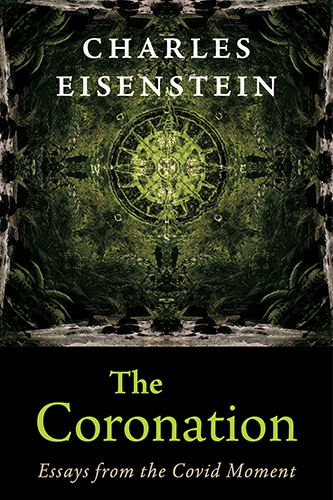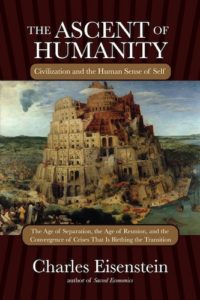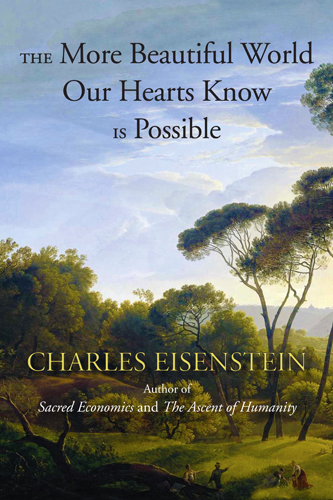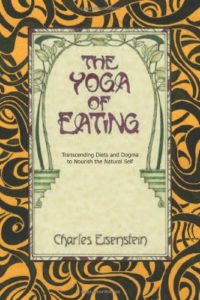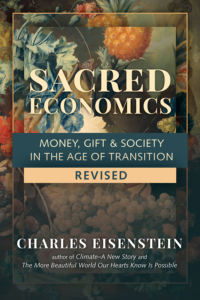Climate — A New Story
Chapters
Chapter 9: Energy, Population, and Development
The Paradigm of Force
As climate change has become the number one focus of environmentalism, discussions about sustainability are increasingly conversations about energy. Unlike biodiversity or ecosystem health, energy is easy to measure, tempting the quantitative mind to equate a sustainable society with sustainable energy sources. Thanks to energy’s amenability to quantitative analysis, we try to extract the issue of energy from a matrix of social and ecological dependencies.
When I first took on writing a chapter about energy, my own quantitative mind leapt at the opportunity to delve into nice clean numbers. I got wrapped up in the minutiae of emissions intensity per kWe, “energy return on energy invested” (EROEI), the relative benefits and risks of various kinds of renewable energy, high-end and low-end projections, and so forth. I felt duty-bound to weigh in, unconsciously influenced by the idea that any “serious” discussion of the energy issue must engage quantitative reasoning. I wanted to know, is it possible to transition to sustainable energy, or isn’t it? The more I read, the more unclear it became, as various authorities stand in foursquare contradiction to each other. I became distracted and depressed. Let me check my email again instead. How about reading some more articles. Or maybe I’ll watch Game of Thrones. I began to understand the seeming apathy and passivity of the public. How different that feeling was from the state I’m in when I’m doing my best work: I can hardly keep away from it. Laziness, resistance, procrastination … maybe these are not problems; maybe they are symptoms, maybe they are the voice speaking to the man in the maze, saying, “Just stop.”
So I did. And I understood that in all I was reading, the questions weren’t big enough and the best-case scenarios weren’t good enough. We can have a paradise on earth, if we only wake up to that choice. The ecological crisis is supposed to be the wake-up call, not a challenge to overcome to stay on our current course.
That is why this book will spare you the graphs and data proving that renewable energy offers a viable future. Or that it doesn’t offer a viable future. Metrics such as EROEI seem at first glance to offer a clean, simple way to evaluate various energy sources, but these seemingly objective numbers typically involve a lot of assumptions and projections that are the grist for endless debate. EROEI tends to be lower in practice than in theory; then there is the matter of accounting for grid dependency. Should the numbers for photovoltaics include some portion of the fossil fuel capacity needed (at the present juncture) to back them up? How do we account for efficiencies of scale and technological improvements? How will other technologies coevolve with energy technology? How will social patterns change? We face the same problem here as we do in removing a species from its web of ecological relationships for carbon accounting. When dealing with a complex interconnected system, there is no such thing as an unbiased number. That is perhaps why published EROEI figures for solar vary so widely, from as low as 0.83 (making it an energy sink)[1] to as high as 14.4.[2] The internet abounds with authoritative demonstrations of why a transition to a renewable energy future is inevitable, and equally authoritative demonstrations of why it is impossible. When I read either of these two positions, I feel stupid for ever having believed the other.
As with the whole climate debate, the energy debate distracts attention from more fundamental issues. What is most significant is that which both sides accept without question. The energy debate takes for granted that it would benefit humanity to continue using a lot of energy (provided it can be done sustainably). It takes for granted current conceptions of development. It takes for granted that human well-being has progressed thanks to increasing energy consumption, which has freed us from toil and allowed each person to benefit from the equivalent of the labor power of thousands of people. It takes for granted the beneficence of systems of medicine and agriculture that require large energy input. In essence, it takes for granted the desirability and necessity of “progress” as we have known it, associating progress with a growing capacity to impose our will on the material world.
That does not mean energy is a nonissue. Something else is at play in our obsession with energy, beyond its easy fit into the quantitative mindset. The harnessing of nonfood energy sources to perform work is virtually unique to human beings. For half a million years, human beings have deliberately used fire to transform materials; for five thousand years, we have used animals to plow fields and carry loads; for several hundred years we have burned coal, oil, and gas to power industrial technology. Our profound impact on the planet owes itself to our harnessing of energy to do work.
What is unique to human beings is also defining of human beings. Who we are as a species relates intimately to what we use for energy. The old story of man over nature extrapolated the exponential increase in energy use into the future, assuming that nuclear power would be as great a leap past fossil fuels as fossil fuels were past firewood and oxen.
The dreams of the early atomic scientists proved vain. Energy availability per capita did not continue its post–World War II exponential rise, but leveled off and in many places even began to decline, nuclear power or no. Energy consumption per capita peaked in America in the 1970s; worldwide it continued to rise as industrialization brought the old technologies of coal and oil to the rest of the world, but it did not rise exponentially. We are nowhere close to replicating the twentieth century’s tenfold increase in energy consumption. “Futuristic” technologies like nuclear fusion are unlikely to reignite the exponential growth that the fossil fuel revolution taught us was normal: (hot) nuclear fusion has been “a few decades away” for my entire lifetime.
What appears to us to be futuristic depends on our conception of the future, which reflects present-day conditions and thinking much more than the actual future. If human progress means progress in dominating nature, then it depends on ever-increasing energy sources. In a cosmological system that denies innate intelligence to matter, an ordered world depends on human ability to impose that order, to move and transform the building blocks of matter. The more energy we have at our disposal, the greater the scale upon which we can impose order.
The Story of Ascent narrates human history as an ever-ascending capacity to impose order onto chaos, intelligence onto randomness, and civilization onto the wild. This triumphalist narrative is breaking down in our time, as the promised technological paradise has receded into the future, a future we now suspect will never come. Instead, conditions on the planet are worsening, to the point where many fear for the survival of civilization entirely. “The conquest of nature” no longer bears the exciting cachet it once did; many of us now reject the very idea of it. Bubble cities and robot servants no longer populate our visions of paradise; we aspire instead to Edenic harmony between human and nature.
Shifting from domination to participation, we understand that we can improve life by cooperating with natural processes, not overcoming them. It takes a lot of energy to run a system of industrial agriculture requiring a war on weeds, bugs, and fungi, and the constant domination of soil chemistry. It takes a lot of energy to run a high-tech medical system based on killing germs and dominating body processes. A force-based system requires a lot of energy—that’s a basic principle of physics. While this approach is extraordinarily effective in many situations such as acute trauma, its energy-intensive, money-intensive methods are far inferior to holistic practices when it comes to most chronic conditions.[3]
And what qualifies a method as “holistic”? It is one that draws on an understanding of the interconnectedness of all things, the intimate connections between self and other. It recognizes an all-pervading intelligence with which we can enter alliance, manifest as the intelligence of the body, the soil, the forest, the ocean, or the planet.
I am not a researcher in the field of holistic medicine, but my personal and secondhand experiences have convinced me that inexpensive, natural methods can cure most “incurable” medical conditions. Intuition tells me that what is true for the human body must also be true for the ecological body, the social body, and the body politic. None of them will be healed by finally mustering enough control to eliminate weeds, terrorists, violence, germs, and so on once and for all. Only by allying ourselves with innate tendencies toward wholeness is a healed world possible.
At risk of drawing too neat an analogy, what most alternative treatments have in common is a respect for the natural healing capacities of the human body, supporting and aligning with them rather than seeking to dominate and control them. They are not based on force. What miracles might be possible if we serve the regeneration and wholeness of Gaia? What might be possible if we strengthen her organs, detoxify her tissues, unblock her fluids?
End Notes
[1] Ferroni and Hopkirk (2016), 336–44.
[2] Koppelaar (2017).
[3] I’m not going to cite a reference here—if you are skeptical you can do your own research. In some areas like hypertension and heart disease, the evidence for the benefits of such things as yoga and meditation is abundant even for those who will only accept quantitative peer-reviewed studies.


